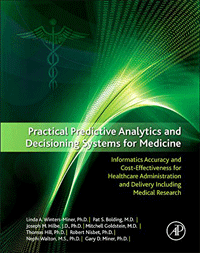Q&A with authors Tom Hill, Gary Miner and Linda Miner
 Last month, Elsevier/Academic Press published a new book titled “Practical Predictive Analytics and Decision Systems for Medicine.”
Last month, Elsevier/Academic Press published a new book titled “Practical Predictive Analytics and Decision Systems for Medicine.”
The book, which aims to give the healthcare industry a blueprint for leveraging predictive analytics and decisioning systems to improve the quality of care, is authored by a host of Ph. D’s, M.D.’s, J.D.’s and industry experts, including Dell’s own Dr. Thomas Hill and Dr. Gary Miner.
The healthcare industry now a major focus of the analytics work being done here at Dell following the acquisition of StatSoft and the Statistica platform.
So, I sat down with Tom and Gary, as well as the book’s lead author, Dr. Linda Miner, to discuss the book, its desired impact and the potential for predictive analytics to revolutionize the healthcare industry.
Why did you write the book?
Linda: We wanted to help the healthcare industry make improvements. There are a lot of problems with our healthcare system today, but at the same time, there are new methods and techniques that the healthcare industry can and should be making use of, and that’s what this book is about.
Gary: Healthcare is not just a little problem, it’s a major problem. The time was right for something like this.
Tom: If you could take the so-called Amazon experience of highly personalized, accurate profiling of what someone is probably going to do next, and turn that loose on healthcare, common sense tells you there’s an incredible amount to be gained. The tricky part is how do you do that, how do you make sure it’s correct, and how do you really implement it? There was really no guidance out there, but a major need, so this book was really timely.
How has the use of analytics in healthcare evolved over time, and what are the biggest barriers to adoption you see right now?
Gary: If you step back, there are really three things that are needed – quality control, predictive analytics, and decisioning systems. Those are the three things we stressed in the book. That last piece is the critical one. Making predictions is the first step, but having decisioning systems in place that enable you to take action immediately and in real-time is the key. Unfortunately, I don’t think we’re at a point where we can say most organizations are even dabbling in analytics for predicting individualized diagnosis and treatment. There are certain exceptions, but most organizations are 15 years behind the time.
Tom: Traditionally, healthcare research has been done in the form of univariate studies. I try a ***, and see if it does any good. In reality, life is more interactive, and it’s imperative that we use more advanced statistical methods. Now, there’s much more at stake for the medical industry than there is for CRM, for example. If someone sends you the wrong catalogue, no harm is done. But based on all the conversations I’ve had with leaders on the provider side, while they know there are barriers to overcome, they also know this is something they need to start embracing.
Gary: With respect to barriers, it comes down to education and acceptance. People at the very top level know they need to leverage modern statistical methods, but they don’t know how to get there. What they need is a roadmap, and that’s what this book offers.
Linda: I also think it’s critical for physicians to understand that the use of analytics and decisioning systems will never replace them, nor does it supplant the clinician’s own sense of what should be. They are aids that can help greatly, but the clinician is still the key driver of care and still has to use his or her intuition. The more people understand and accept that, the more we’ll see this gain traction.
What are some of the most prevalent ways proactive providers are leveraging analytics in order to improve the quality of patient care?
Tom: As an example, when a patient has surgery, there are certain risks that are both dangerous for the patient and costly for the provider. The risk of infection is one of them. The cost of re-hospitalization when you have an infection is enormous. We’ve worked with hospitals that today are using predictive analytics and decisioning systems to reduce the risk of infection. As a surgery is taking place, they’re inputting real-time data into a decisioning system. The system them combines the patient’s historical information with the information about what’s happening right at that very moment, and indicates to the surgeon if there are any particular risks related to infection at the incision point. The surgeon can then use that information to make on-the-spot decisions about how to go about closing and treating the incision in order to reduce the risk of infection. They’ve been very successful doing this and it’s something where the ROI is immediate and obvious.
Where do you see this evolving to next? What are we not doing today that analytics will help us do down the road?
Gary: I think it’s important to first point out that great things are already happening. For example, there’s a decisioning system that predicts a heart attack four hours in advance of it happening, before the physician can even predict it. That’s reality right now.
Tom: If this is done right, we can eventually do things remotely and instantaneously that today would take a tremendous amount of time, resources, attention and experience. We can monitor patients remotely to determine if they have a pending emergency. Hospital re-admissions can be driven down dramatically. We can potentially diagnose depression automatically. We can predict risk much more accurately.
Linda: We now have the ability to constantly collect data through devices. If physicians can get hold of that data and add it to predictive models, we could get to a point where doctors are calling patients in for appointments, not the other way around. It could completely flip the current healthcare model. We’d be working toward wellness, rather than treating people who are already sick. That’s how you improve healthcare.
If readers could take one thing away from your book, what would you like it to be?
Linda: I hope it gets people excited and hopeful about their ability to change the industry. We have many problems that need fixing. Physicians are feeling more powerless than ever. All the retractions in medical journals you’re now seeing – that should say something. I’ve had three family members – both of my parents and my brother – die from misdiagnosis. Knowing we now have the capabilities needed to prevent things like that from happening, I have to hope people will take this book and use it to make things better.
Tom: In general, in order to apply predictive analytics to outcomes that really affect your life, you need to follow best practices. One of the biggest problems today is that the best practices for using analytics in healthcare are just not widely known or documented. That’s what I hope people get out of the book. The work we’re doing with Statistica, the things we outline in this book – we’re trying to give people the roadmap they need.
Gary: Roadmap is a great way to describe it. This is the roadmap for the future. This has to happen. There’s no alternative. I had an eye problem recently, and I went to five different doctors and they gave me five different opinions and five different treatment options. That shouldn’t be happening in this day and age. We think this book can be a turning point in medicine and we hope that it has that type of impact.
